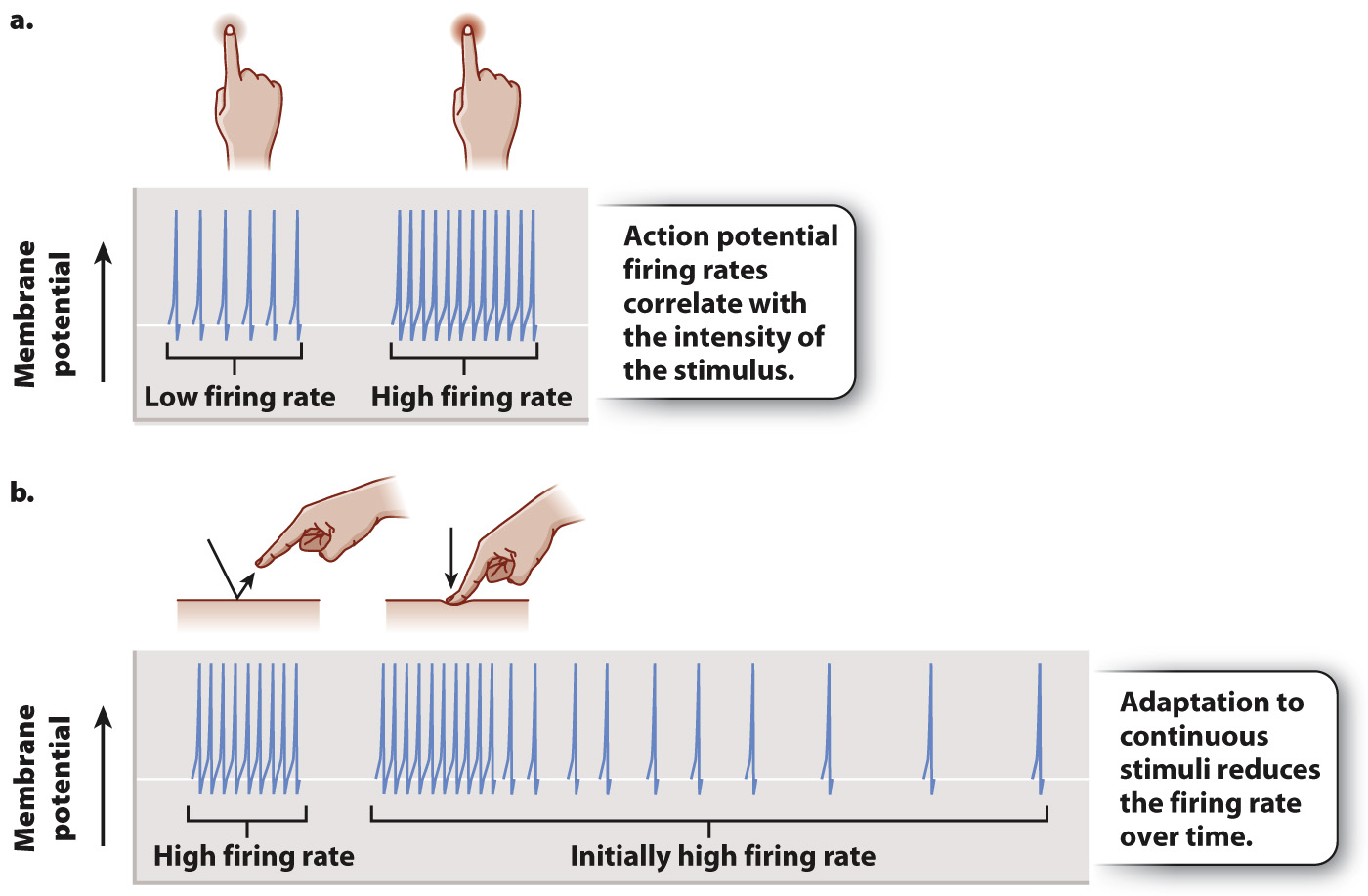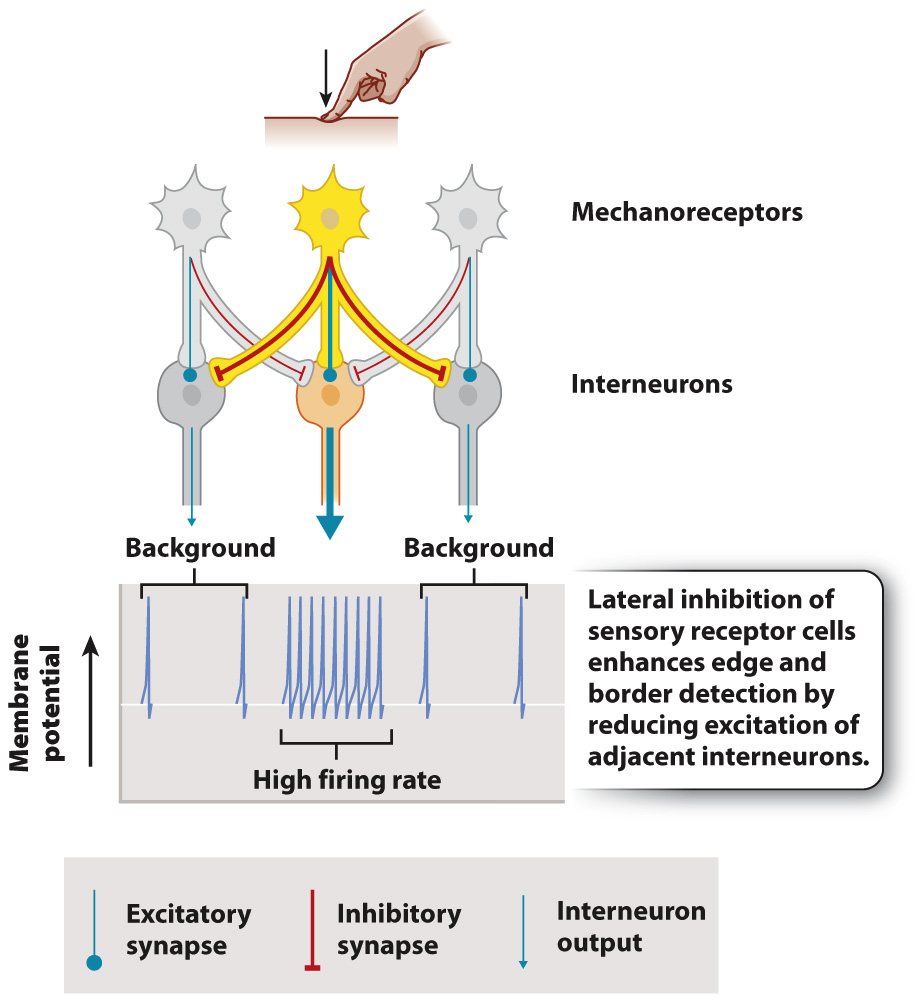Stimuli are transmitted by changes in the firing rate of action potentials.
Sensory reception depends on converting the energy of a physical or chemical stimulus into an action potential, either in the sensory receptor itself or in the neuron it synapses with. How do these nerve impulses convey information to the brain? In effect, action potentials can be considered a code that the brain deciphers.
To convert information from the environment into a code, the nerve impulses conveyed by sensory organs carry out the following functions:
765
Convey the strength of the incoming signal—
for example, the brightness of light, the loudness of a sound, or the intensity of an odor. Carry information about even weak signals when necessary.
Convey the location of a signal’s source—
for example, where the body is touched. Filter out unimportant background signals.
Because nerve cells transmit action potentials in an all-

Several mechanisms increase a nerve cell’s sensitivity to even weak signals. Following sensory transduction, the signal typically undergoes initial processing. As discussed in Chapter 35, sensory stimuli may be summed over space or time. Signals from multiple sensory receptors often converge onto a neighboring neuron, which increases its firing rate proportionally to the number of signals received. This is an example of spatial summation. Combining the synaptic input increases the receptor organ’s sensitivity to weak external signals.
Another way to increase sensitivity to external signals is through temporal summation, summing sensory stimuli that are received repeatedly over time by the same sensory cell. When a sensory cell is stimulated more frequently, the excitatory postsynaptic potentials (EPSPs) sum, and the cell is more likely to become depolarized above threshold and fire an action potential.
Sensory receptors also distinguish between discrete (intermittent) and continuous stimuli, providing a way to ignore background noise. Novel stimuli are generally the most important for an animal. Consequently, sensory receptors initially respond most strongly when a stimulus is first received (Fig. 36.3b). If the stimulus continues over a longer time period, sensory receptors typically reduce their firing rate through a process called adaptation (this is not the adaptation that results from natural selection). Adaptation of firing rate enables an animal’s sensory receptors to focus on novel stimuli, which are those likely to be most important. You can experience adaptation by touching your skin lightly at a particular location. Initially, skin mechanoreceptors fire in response to the touch, but after a while their firing rate diminishes and the sensation of a touch becomes less noticeable. Adaptation also ensures that the clothes touching your skin do not cause an irritating and distracting long-
Sensory receptors locate a signal’s source by lateral inhibition (Fig. 36.4). Lateral inhibition enhances the strength of a sensory signal locally but diminishes it peripherally. Sensory receptors have multiple extensions. Some make contact with nearby interneurons, while others make contact with interneurons farther away, in adjacent regions. In lateral inhibition, receptors send inhibitory signals to adjacent regions of the sensory organ, and send excitatory signals to interneurons within their local region. This increases the contrast in signal strength between adjacent regions. For example, lateral inhibition in the retina of the eye enhances edge detection and sharpens image contrast. Lateral inhibition in the skin enables the sense of touch to be localized to a small region of the body surface. The inhibitory and excitatory signals are transmitted to the interneurons by synapses that have different neurotransmitters.

We have not yet described all the information in the code. How do action potentials convey pitch or color or a particular odor? This information is conveyed by the identity of the particular sensory receptors that are activated. Sensory organs are constructed so that, for example, tone A activates “tone A” sensory neurons in the ear, red light activates “red” sensory neurons in the eye, and the fragrance of vanilla activates “vanilla” sensory neurons in the nose. The way in which the “correct” sensory receptor is excited varies for each of the senses. In the next three sections, we discuss how this happens for smell and taste, hearing, and vision.
766
Quick Check 1 Aspirin and ibuprofen reduce pain by inhibiting the synthesis of chemicals called prostaglandins. What effect would you predict prostaglandins to have on the firing rate of nociceptors?
Quick Check 1 Answer
Prostaglandins depolarize nociceptors and increase their firing rate.